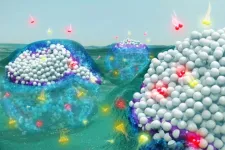Mysterious organic scum boosts chemical reaction efficiency, may reduce chemical waste
2021-02-04
(Press-News.org) CHAMPAIGN, Ill. -- Chemical manufacturers frequently use toxic solvents such as alcohols and benzene to make products like pharmaceuticals and plastics. Researchers are examining a previously overlooked and misunderstood phenomenon in the chemical reactions used to make these products. This discovery brings a new fundamental understanding of catalytic chemistry and a steppingstone to practical applications that could someday make chemical manufacturing less wasteful and more environmentally sound.
The study led by University of Illinois Urbana-Champaign researcher David Flaherty, University of Minnesota, Twin Cities researcher Matthew Neurock and Virginia Tech researcher Ayman Karim is published in the journal Science.
Combining solvents and metal nanoparticles accelerates many chemical reactions and helps maximize yield and profit margins for the chemical industry. However, many solvents are toxic and difficult to safely dispose, the researchers said. Water works, too, but it is not nearly as efficient or reliable as organic solvents. The reason for the difference was thought to be the limited solubility of some reactants in water. However, multiple irregularities in experimental data have led the team to realize the reasons for these differences were not fully understood.
To better understand the process, the team ran experiments to analyze the reduction of oxygen to hydrogen peroxide - one set using water, another with methanol, and others with water and methanol mixtures. All experiments used palladium nanoparticles.
"In experiments with methanol, we observed spontaneous decomposition of the solvent that leaves an organic residue, or scum, on the surface of the nanoparticles," said Flaherty, a professor of chemical and biomolecular engineering at Illinois. "In some cases, the scumlike residue clings to the nanoparticles and increases reaction rates and the amount of hydrogen peroxide formed instead of hampering the reaction. This observation made us wonder how it could be helping."
The team found that the residue, or surface redox mediator, holds oxygen-containing species, including a key component hydroxymethyl. It accumulates on the palladium nanoparticles' surface and opens new chemical reaction pathways, the study reports.
"Once formed, the residue becomes part of the catalytic cycle and is likely responsible for some of the different efficiencies among solvents reported over the past 40 years of work on this reaction," Flaherty said. "Our work provides strong evidence that these surface redox mediators form in alcohol solvents and that they may explain many past mysteries for this chemistry."
By working with multiple types of experiments and computational simulations, the team learned that these redox mediators effectively transfer both protons and electrons to reactants, whereas reactions in pure water transfer protons easily, but not electrons. These mediators also alter the nanoparticles' surface in a way that lowers the energy barrier to be overcome for proton and electron transfer, the study reports.
"We show that the alcohol solvents as well as organic additives can react to form metal-bound surface mediators that act much in the same way that the enzymatic cofactors in our bodies do in catalyzing oxidation and reduction reactions," Neurock said.
Additionally, this work may have implications for reducing the amounts of solvent used and waste generated in the chemical industry.
"Our research suggests that for some situations, chemical producers could form the surface redox mediators by adding small amounts of an additive to pure water instead of pumping thousands of gallons of organic solvents through these reactors," Flaherty said.
INFORMATION:
The Energy and Biosciences Institute through the EBI-Shell program and the National Science Foundation supported this research.
Editor's notes:
To reach David Flaherty, call 217-244-2816; email dwflhrty@illinois.edu.
The paper "Solvent molecules form surface redox mediators in situ and cocatalyze oxygen reduction on Pd" is available from the U. of I. News Bureau
[Attachments] See images for this press release:

ELSE PRESS RELEASES FROM THIS DATE:
2021-02-04
For more than a century, optical coatings have been used to better reflect certain wavelengths of light from lenses and other devices or, conversely, to better transmit certain wavelengths through them. For example, the coatings on tinted eyeglasses reflect, or "block out," harmful blue light and ultraviolet rays.
But until now, no optical coating had ever been developed that could simultaneously reflect and transmit the same wavelength, or color.
In a paper in Nature Nanotechnology, researchers at the University of Rochester and Case Western Reserve University describe a new class of optical coatings, so-called Fano Resonance Optical Coatings (FROCs), that can be used on filters to reflect and transmit colors of remarkable purity.
In addition, ...
2021-02-04
The rapid development of silicon-based transistors leads to its integration getting closer to the limit of Moore's law. Graphene is expected to become the next generation of mainstream chip materials due to its ultra-high carrier mobility. However, it is difficult to obtain a high on/off current ratio for intrinsic graphene-based transistor owing to the absence of bandgap. Graphene nanoribbons, which possess a tunable bandgap and unique optoelectrical properties, have attracted extensive attention and exploration.
Nowadays, the preparation of graphene nanoribbons is underdeveloped, and common strategies include the clip of carbon materials (graphene films, carbon nanotubes, or graphite) ...
2021-02-04
When we think about the links to the future - the global transition to solar and wind energy, tactile virtual reality or synthetic neurons - there's no shortage of big ideas. It's the materials to execute the big ideas - the ability to manufacture the lithium-ion batteries, opto-electronics and hydrogen fuel cells - that stand between concept and reality.
Enter two-dimensional materials, the latest step in innovation. Consisting of a single layer of atoms, two-dimensional materials like graphene and phosphorene exhibit new properties with far-reaching potential. With a capability to be combined like Lego bricks, these materials ...
2021-02-04
CLEVELAND--Researchers at Case Western Reserve University, using artificial intelligence (AI) to analyze simple tissue scans, say they have discovered biomarkers that could tell doctors which lung cancer patients might actually get worse from immunotherapy.
Until recently, researchers and oncologists had placed these lung cancer patients into two broad categories: those who would benefit from immunotherapy, and those who likely would not.
But a third category--patients called hyper-progressors who would actually be harmed by immunotherapy, including a shortened lifespan after treatment--has begun ...
2021-02-04
PITTSBURGH, Feb. 4, 2021 - Researchers at UPMC Hillman Cancer Center and the National Cancer Institute (NCI) demonstrate that changing the gut microbiome can transform patients with advanced melanoma who never responded to immunotherapy--which has a failure rate of 40% for this type of cancer--into patients who do.
The results of this proof-of-principle phase II clinical trial were published online today in Science. In this study, a team of researchers from UPMC Hillman administered fecal microbiota transplants (FMT) and anti-PD-1 immunotherapy to melanoma patients ...
2021-02-04
Despite living in the same part of the Mojave Desert, and experiencing similar conditions, mammals and birds native to this region experienced fundamentally different exposures to climate warming over the last 100 years, a new study shows; small mammal communities there remained much more stable than birds, in the face of local climate change, it reports. The study presents an integrative approach to understanding the climate vulnerability of biodiversity in rapidly warming regions. Exposure to rising temperature extremes threatens species worldwide. It is expected to push many ever closer toward extinction. Thus, understanding ...
2021-02-04
The soundscapes of the Anthropocene ocean are fundamentally different from those of pre-industrial times, becoming more and more a raucous cacophony as the noise from human activity has grown louder and more prevalent. In a Review, Carlos Duarte and colleagues show how the rapidly changing soundscape of modern oceans impacts marine life worldwide. According to the authors, mitigating these impacts is key to achieving a healthier ocean. From the plangent songs of cetaceans to grinding arctic sea ice, the world's oceans' natural chorus is performed by a vast ensemble of geological (geophony) and biological (biophony) sounds. However, for more than a century, ...
2021-02-04
In February 2001, the first drafts of the human genome were published. In this Special Issue of Science, "Human Genome at 20," an Editorial, a Policy Forum, a series of NextGen Voices Letters and a Perspective explore the complicated legacy of the Human Genome Project (HGP). "Millions of people today have access to their personal genomic information, with direct-to-consumer services and integration with other 'big-data' increasingly commoditizing what was rightly celebrated as a singular achievement in February 2001," writes Science Senior Editor Brad Wible.
An Editorial by Claire Frasier, director of the Institute for Genome Sciences at the University ...
2021-02-04
Iodine plays a bigger role than thought in rapid new particle formation (NPF) in relatively pristine regions of the atmosphere, such as along marine coasts, in the Arctic boundary layer or in the upper free troposphere, according to a new study. The authors say their measurements indicate that iodine oxoacid particle formation can compete with sulfuric acid - another vapor that can form new particles under atmospheric conditions - in pristine atmospheric regions. Tiny particles suspended high in the atmosphere - aerosols - play an essential role in Earth's climate system. Clouds require airborne particles, or cloud condensation nuclei (CCN), ...
2021-02-04
For patients with cancers that do not respond to immunotherapy drugs, adjusting the composition of microorganisms in the intestines--known as the gut microbiome--through the use of stool, or fecal, transplants may help some of these individuals respond to the immunotherapy drugs, a new study suggests. Researchers at the National Cancer Institute (NCI) Center for Cancer Research, part of the National Institutes of Health, conducted the study in collaboration with investigators from UPMC Hillman Cancer Center at the University of Pittsburgh.
In the study, some patients with advanced melanoma who initially did not respond to treatment with an immune checkpoint inhibitor, a type of immunotherapy, did respond to the drug after receiving a transplant ...
LAST 30 PRESS RELEASES:
[Press-News.org] Mysterious organic scum boosts chemical reaction efficiency, may reduce chemical waste


